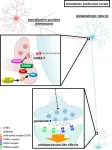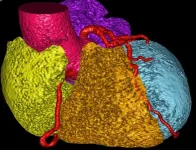The global burden of anxiety- and depression-related disorders is on the rise. While multiple drugs have been developed to treat these conditions, current medications have several limitations, including slow action and adverse effects with long-term use. This underscores the urgent need for novel, rapidly-acting therapeutic agents with minimal side effects.
The delta opioid receptor (DOP) plays a key role in mood regulation, making it a promising target for therapeutic intervention. Studies have shown that selective DOP agonists (compounds that activate DOP), such as SNC80 and KNT-127, exert antidepressant and anxiolytic effects (anti-anxiety) in animal models. However, the precise molecular mechanisms underlying their actions remain unclear. Understanding the neurological mechanisms that underpin mood regulation and DOP action is crucial for advancing DOP agonists as therapeutic agents.
To this end, Professor Akiyoshi Saitoh and Mr. Toshinori Yoshioka from Tokyo University of Science (TUS), Japan, conducted a series of experiments to elucidate the cellular and molecular processes contributing to the antidepressant-like effects of KNT-127. Providing further insight into their work published online on December 6, 2024 in Molecular Psychiatry, Prof. Saitoh says, “Combining the results of this study with our previous findings, we believe that DOP agonists have an unprecedented mechanism of action and have the potential to revolutionize depression treatment with superior efficacy and safety compared to existing drugs.”
In their previous work, the researchers conducted the forced swimming test (FST), which is known to induce depression-like helplessness behavior in untested mice, to investigate whether KNT-127 produces antidepressant-like effects. They compared the response of animals treated with KNT-127 and controls. Notably, a single injection of KNT-127, 30 minutes prior to the test, significantly reduced immobility count, reflecting an antidepressant-like effect mediated by DOP stimulation.
The mechanistic (or mammalian) target of rapamycin (mTOR) signaling pathway, implicated in rapid antidepressant effects, was investigated for its role in KNT-127’s action. The researchers injected the mice with rapamycin—an mTOR inhibitor—prior to KNT-127 treatment. Indeed, rapamycin reversed the KNT-127-induced decrease in the FST immobility count, indicating that the antidepressant-like effects of KNT-127 were mediated by mTOR signaling.
Next, researchers analyzed the mTOR signaling-related protein activation in brain regions associated with mood disorders and mapped distinct phosphorylation patterns in the medial prefrontal cortex (mPFC), amygdala, and hippocampus. The experiments revealed that the antidepressant-like effects were primarily mediated by Akt signaling in the mPFC, while the anxiolytic effects were associated with activation of the amygdala through ERK signaling.
Further studies in a mouse model of depression revealed that when KNT-127 was locally injected into the medial prefrontal infralimbic cortex region (IL-PFC), an anti-depressive effect was produced through the PI3K and mTOR pathway. The IL-PFC in rodents is considered functionally similar to Brodmann Area 25 in humans, which is associated with mood regulation. Further, the antidepressant-like effects of KNT-127 were independent of the strain, sex, or age of the animals, and another DOP agonist, SNC80, also exhibited antidepressant-like effects, highlighting the broad therapeutic potential of DOP agonists.
Additionally, KNT-127's application to isolated IL-PFC brain tissue enhanced glutamatergic transmission by suppressing the release of gamma-aminobutyric acid (GABA—a key neurotransmitter), further supporting the direct action of DOPs on the IL-PFC. The study identified that most DOPs were expressed in parvalbumin-positive interneurons in the IL-PFC, offering new insights into the cell-specific expression of DOP in distinct brain regions, thereby expanding our understanding of its mechanisms.
Prof. Saitoh concludes with the clinical implications of their work by saying “Our results provide a proof of mechanism underlying the antidepressant effect of DOP and can significantly boost the clinical development of DOP agonists as therapeutics. Moreover, the IL-PFC is the region involved in resistance to treatment with conventional antidepressants. DOP agonists may, therefore, be more effective in patients who show resistance to existing therapies.”
We hope these findings translate into an effective treatment for those battling depression.
***
Reference
Title of original paper: Delta opioid receptor agonists activate PI3K–mTORC1 signaling in parvalbumin-positive interneurons in mouse infralimbic prefrontal cortex to exert acute antidepressant-like effects
Journal: Molecular Psychiatry
DOI: https://doi.org/10.1038/s41380-024-02814-z
About The Tokyo University of Science
Tokyo University of Science (TUS) is a well-known and respected university, and the largest science-specialized private research university in Japan, with four campuses in central Tokyo and its suburbs and in Hokkaido. Established in 1881, the university has continually contributed to Japan's development in science through inculcating the love for science in researchers, technicians, and educators.
With a mission of “Creating science and technology for the harmonious development of nature, human beings, and society," TUS has undertaken a wide range of research from basic to applied science. TUS has embraced a multidisciplinary approach to research and undertaken intensive study in some of today's most vital fields. TUS is a meritocracy where the best in science is recognized and nurtured. It is the only private university in Japan that has produced a Nobel Prize winner and the only private university in Asia to produce Nobel Prize winners within the natural sciences field.
Website: https://www.tus.ac.jp/en/mediarelations/
About Professor Akiyoshi Saitoh from Tokyo University of Science
Dr. Akiyoshi Saitoh is a Professor in the Department of Pharmaceutical Sciences at Tokyo University of Science. His research interests include drug discovery pharmacology, neuroscience, and behavioral pharmacology. The Saitoh research group led by him is currently developing animal models to understand human neural circuits. In the area of drug research, they are developing antidepressants, anxiolytics targeting opioid receptors, and antipsychotics. Additionally, they also study the psychological and neural effects of ultrasonic and electromagnetic waves. Dr. Saitoh has published over 100 peer-reviewed articles since starting out in the field of neuro-psychopharmacological science in 1994.
Funding information
This research was supported by funding received from the Cyclic Innovation for Clinical Empowerment as part of the Japan Agency for Medical Research and Development (AMED) under Grant Number JP17pc0101018.
END






